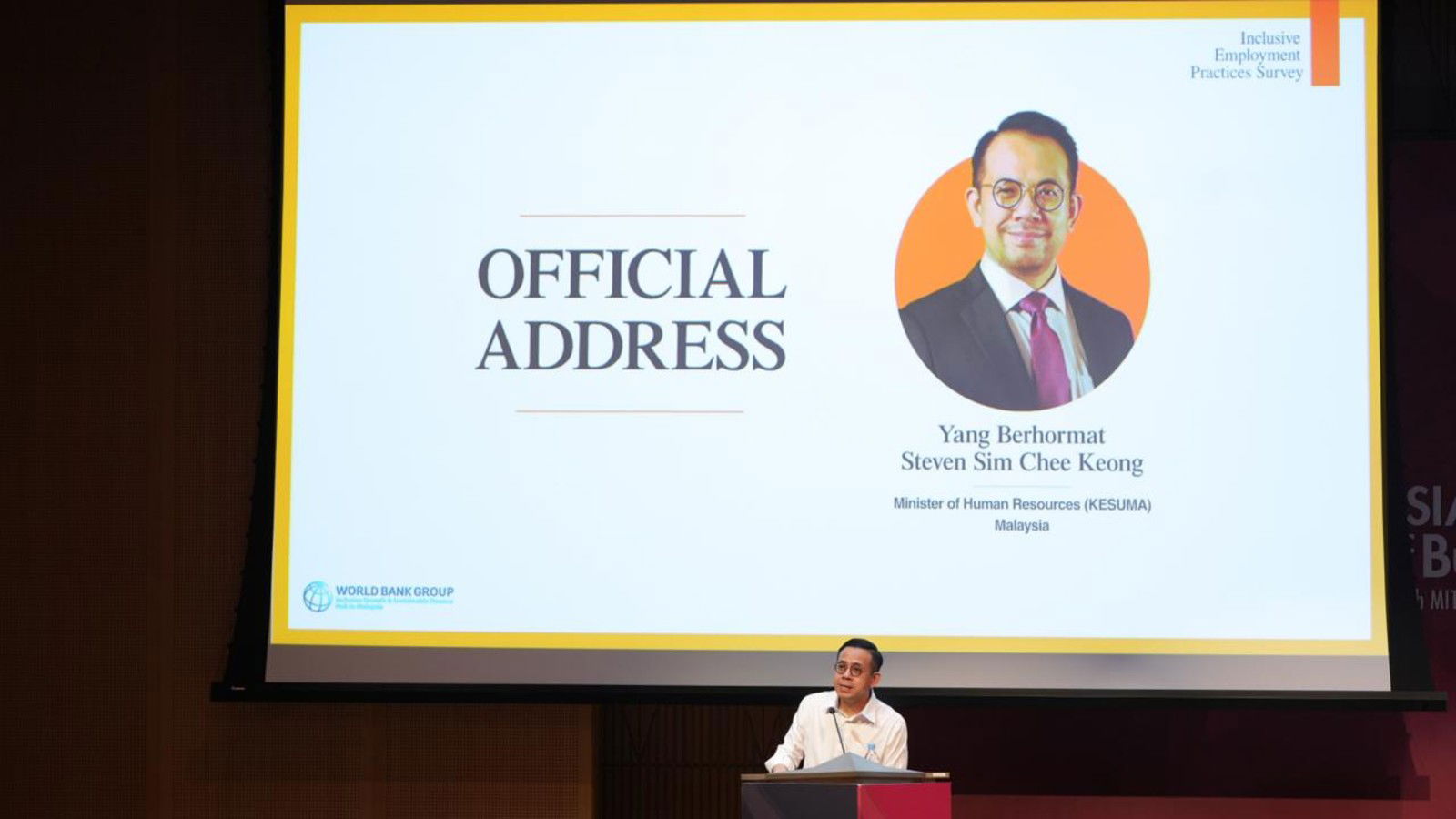share on
According to the 2024 survey, women aged 21-30 make up 41% of the female workforce – a pattern consistent across sectors and firm sizes, while representation declines sharply with age. This mirrors national labour trends, where many women exit the workforce permanently after starting families.
Malaysia's Human Resource Minister, Steven Sim, recently launched the country's Inclusive Employment Practices Report by the World Bank, which features key strategies to ensure Malaysia's workforce remains sustainable.
The report focuses on multiple factors, including women in the workforce, flexible work arrangements, and childcare as an investment for the future of the workforce.
In this article, we will focus on the retention of women in Malaysia's workforce.
One of Malaysia’s biggest challenges in raising female labour force participation (FLFP) is retaining women in the workforce. FLFP peaks among women aged 25-29 but declines as many leave after starting a family, often permanently. Unlike other countries where women often return after career breaks, Malaysian women’s exits tend to be lasting, with one of the lowest rates of temporary career breaks.
Past studies cite housework, including child and elderly care, as the main reason women don’t seek work. Despite shifting norms, lack of childcare options forces many women out of the labour market; and have worsened due to inflexible, unsupportive workplaces.
Even in countries where more women return, care duties and lack of career support remain barriers. Career breaks often lead to wage penalties and downward job mobility. Women also face hiring discrimination due to perceptions of outdated skills and limited commitment.
Still, studies suggest childcare support, hybrid/flexible work arrangements, and targeted training can improve women’s labor participation and career growth.
Female employees make up a smaller share than males across surveyed firms — 47% versus 53%. This aligns with national stats: male labour force participation is 83.4%, while female participation is 56.6% in 2024. Notably, women are better represented in micro-SMEs (MSMEs) at 47%, compared to 42% in large firms. Firms aged 20-30 years have the lowest female share, between 35-39%, whereas other firms show higher shares of 45-50%.
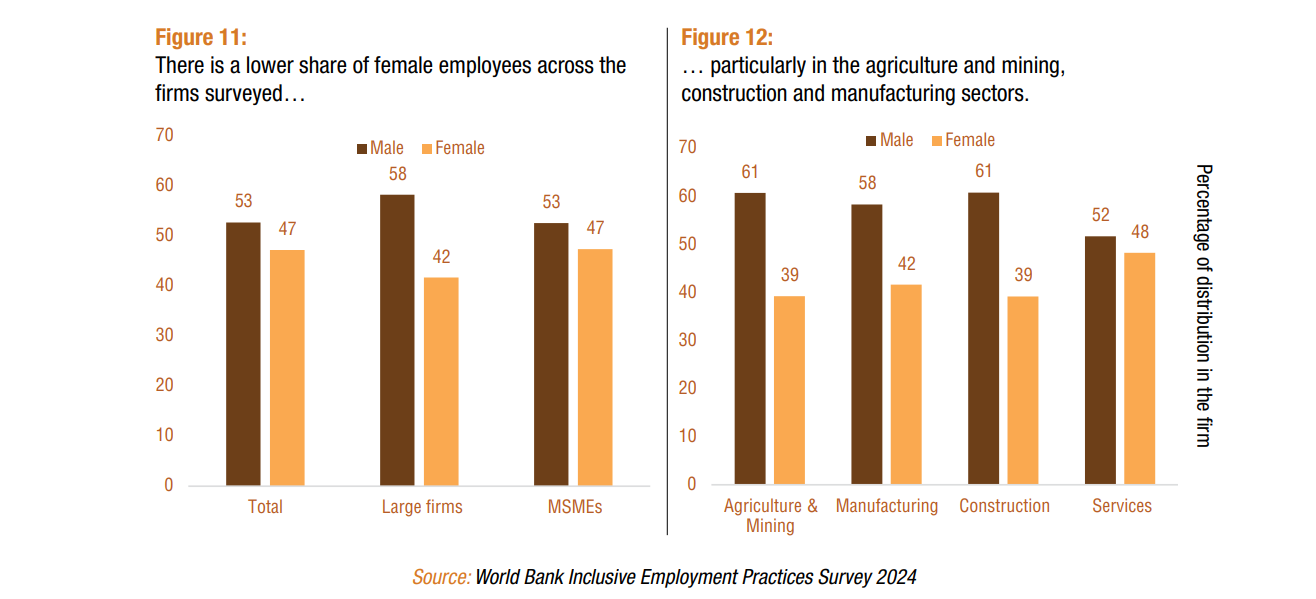
Lower concentration of women in high- or mid-level positions
Overall, the distribution of female employees across different levels of positions in the firms is fairly similar across all levels of management; high-level or senior management, mid-level or technical and entry-level or administrative, at around 30%.
This is particularly in the case of MSMEs where the difference in the distribution is minimal at only 1.5%. However, in large firms, there is a lower concentration of female employees at the high-level positions at 28%, followed by mid-level at 33% and entry-level at 40%.
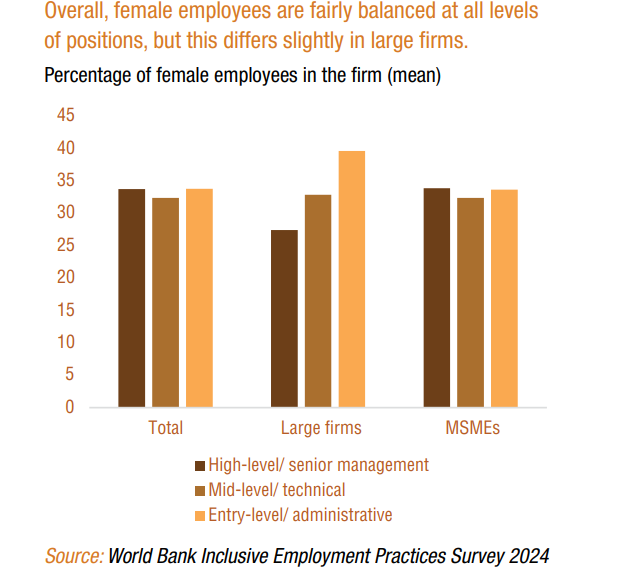
The proportion of female employees at the firms surveyed decreases with age
Women aged 21-30 make up the largest share of female employees at 41%, followed by 31-40 years at 32%, 41-50 years at 17%, and over 50 at 10%. This pattern is consistent across firm size, region, sector, and years of operation, reflecting more women hired at entry-and mid-levels. It also mirrors Malaysia’s FLFP trend, where women join the workforce in their 20s but often leave permanently after starting families — unlike in other countries where women typically return after caregiving breaks.
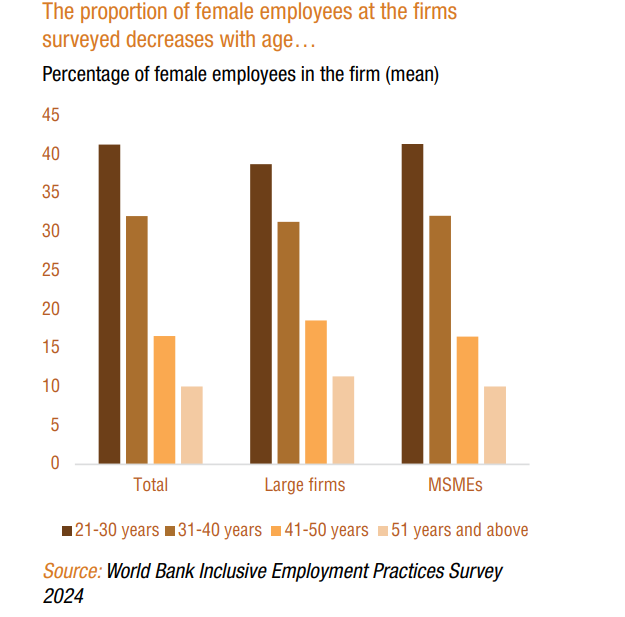
Despite these statistics, majority of the firms surveyed actually acknowledged that hiring more women would have a positive impact to the firm, with 62% agreeing that hiring more women would improve productivity. Additionally, 53% of respondents indicated that bringing more women into the workforce would improve the firms' ability to attract better talent.
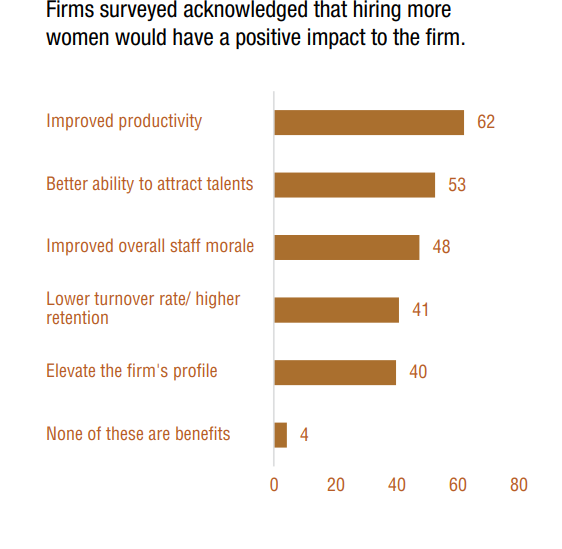
However, over half of surveyed firms reported that women’s family commitments (58%) and meeting government regulations like maternity leave (54%) are their main challenges in hiring women. These concerns were more common among MSMEs than large firms. Additionally, over 40% cited higher costs from required benefits and facilities, such as lactation rooms or childcare — especially in construction, where nearly 70% flagged these as key issues. Fewer firms (35%) felt hiring women would disrupt the work environment.
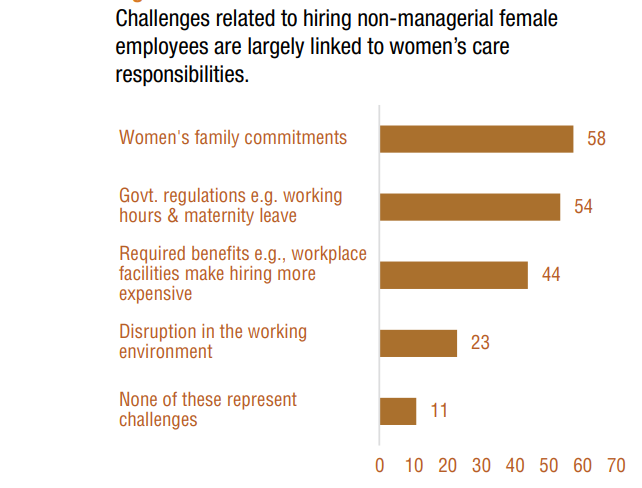
In that vein, firms have purposefully implemented measures that would promote a more inclusive workforce, therefore increasing the rate of retention in women. FWAs and childcare benefits were the most frequently cited measures that firms, regardless of firm size are planning to undertake or expand within the next 12 months to have a more inclusive workforce.
Popular measures include offering childcare subsidies and subsidised prenatal check-ups and childbirth (49%), as well as providing onsite childcare facilities and lactation rooms (49%). Around 45% of firms plan to establish committees or divisions focused on fostering a more inclusive workforce. However, fewer than 40% are considering extending maternity and paternity leave policies.
When it comes to government incentives to help firms encourage the hiring of more women, an overwhelming number of firms (73%) indicated that it welcomes incentives or subsidies from the government for firms that offer additional benefits for women employees. Additionally, 64% of firms agreed that training programmes to help integrate women who are returning to the workforce would be beneficial. Fewer firms indicated that a longer mandated paternity leave would be helpful for them to hire more women.
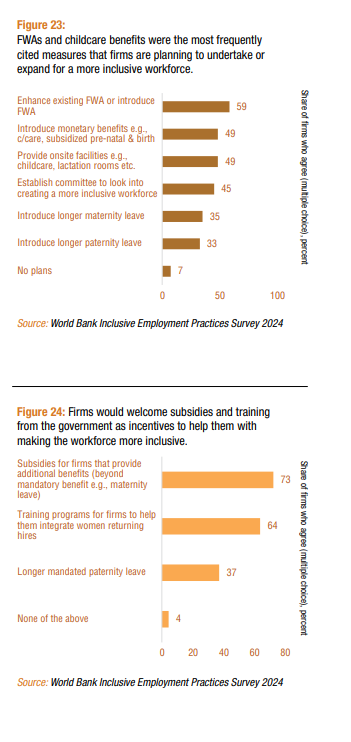
The report also tackled issues such as
- Flexible working arrangements
- While slightly more firms are operating fully on-site, a number of firms have adopted some form of flexibility
- Managing employees and productivity are the main reasons cited for firms to operate fully on-site
- Employees wellbeing and motivation are the main reasons for firms to adopt hybrid or FWA
- Regardless of current arrangements, more clarity and training on flexible working would be beneficial for firms
- Childcare benefits
- Flexible working and the provision of childcare facilities are the most common benefits that firms offer
- Most childcare facilities that firms offer are fully occupied
- Most firms are looking to expand their childcare benefits
How Malaysia is helping and supporting employees and career returnees' needs
To date, the government has introduced various measures for both firms and employees:
- The Malaysian government, through TalentCorp under the Ministry of Human Resources, supports women returning to work with initiatives like the Career Comeback Programme (CCP), which offers up to 12 months of income tax exemptions for eligible women returnees. So far, 2,700 women have registered, and 351 companies have hired CCP participants.
- Budget 2025 introduced incentives for firms hiring women returnees, including a 50% income tax exemption for 12 months and an additional 50% tax deduction for firms providing up to 12 months of paid care leave for employees caring for sick or disabled family members.
- To promote flexible work, the government launched the Flexible Work Arrangement Guidelines (AKF) under TalentCorp’s MyWira initiatives, providing clear frameworks, consultations, readiness assessments, and workshops. Tax incentives for capacity building and software development further encourage flexible work adoption and workplace inclusivity.
In a Facebook post, KESUMA stated: "This report proves that increasing the participation rate of women can be a strategic solution to ensure sustainable and competitive economic growth of the country.
"KESUMA is committed to ensure employment policies and practices in Malaysia are more progressive and woman-friendly, including through incentives to employers who provide childcare and flexible work facilities."
READ MORE: Malaysia outlines ongoing efforts and gaps in tackling workplace discrimination
Lead image / KESUMA Facebook
Infographics / Inclusive Employment Practices in Malaysia Report
share on

